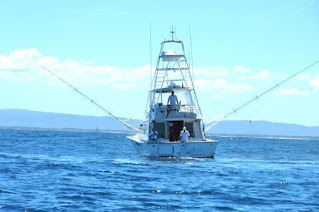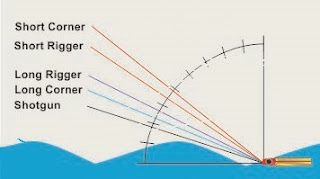Small Boat Outriggers - Avoiding Lure Trolling
You've probably guessed the subject of this article as
Outriggers - Lure Trolling which is a pretty good hint, but perhaps you should
read Why Your Boat Might Be Set Up Wrong If You Have a Sport fisher 25 Feet or
Smaller.
There has been endless debate over which engines will get
you more fish, 2 stroke, 4 stroke, outboards, inboards, diesels and so on.
Usually, the result is that larger boats with diesel engines will catch more
fish, but perhaps they have nothing to do with the size of the boat and
engines, perhaps it's all about the outriggers!
Let's do the Comparison
Larger boats have very long outriggers, check the length and
how high the outrigger tips are above the surface of the water, and as we look
at the boat, notice how high the outriggers are that control how high the rod
tips go when fishing Rods that are run from the rod tips and not in the
outriggers.
Here's a medium-sized sport fisher in Australia. It is completely different from a big boat. The rigs are much shorter
and have very low limbs in relation to the water, plus the gunwales are much
lower than larger boats.
Here's the problem, at the same trolling speed, the prop
wash is longer on a small boat than it is on larger boats, not just in
proportion, but actually longer. In percentage terms, the width of the prop
wash to the width of the boat is wider on a smaller boat. So, of the two boats,
which one needs longer and higher gear to get the same performance from the
same set of lures? It may be easier now to understand that the bait and gear
used by a larger boat will not perform as well on a smaller boat.
There are no terms that I know of to describe the difference in post washers and the difference in length or height of posts. The terminology is the same for all rigged boats as shown: i.e. Short Corner, Long Corner, Short Rigger, Long Rigger, and Shotgun.
Unfortunately, there is no common terminology at all for
bait positions on outrigger boats.
They don't have outriggers, so they don't have outrigger sites. Attempting to describe situations is not easy.
The reason all of this is important is that the factors that
govern a lure's performance are speed, the position of the lure on the face of
the pressure waves, and the angle of the leader relative to the water.
However, the truth is that these angles are difficult to
achieve as there is slack or belly in the line so that the bait is pulled
rather than caught.
The higher bar and outrigger tips on larger boats as
previously described largely compensate for achieving a much higher entry
angle. Unfortunately, smaller boats have many more leaders running in front of
the bait.
There are several reasons why a high angle of entry is
important:
1-The lure is more stable, meaning it spins less, so the
hooks are in a better position to get results.
2-There is less leader in the water, so there is less leader
impact, and the bait is more active and has a more consistent action.
So, pretty much right now, if you're fishing from a big boat
with long jigs, you're pretty happy. If you're fishing from a small boat with
short tackle, you're probably thinking that maybe it's time to ditch the bait
and try something else. Never be afraid as there are some things you can do to
improve the performance of the lure on your boat.
Getting longer equipment is definitely the easiest solution. There are a number of outrigger companies that offer carbon fiber and aluminum outriggers (Affordable prices at CKW Store) that are both lightweight and incredibly tough. There are a number of easy-to-use bases that provide easy adjustment of height and distance.
Related Articles:







Comments
Post a Comment